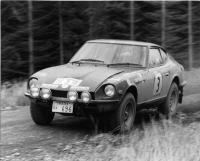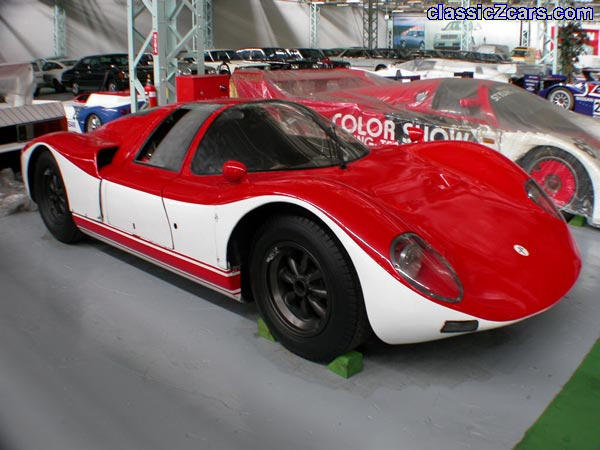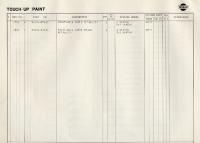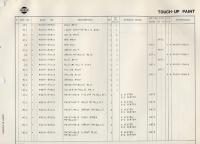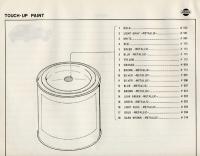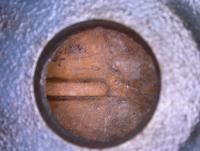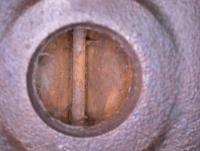Everything posted by HS30-H
-
Philosophical discusion on build dates
Hi 26th-Z, Actually, I don't think I ever thought to mention this to you before: HS30-00026 - along with HS30-00024, HS30-00025 & HS30-00027 -was one of the first Nissan / Datsun "Works" 240Z rally cars. They debuted in their first official team rally on the 1970 RAC Rally here in the UK ( in November 1970 ). HS30-00026 was issued with the Japanese 'carnet' registration plate number "TKS 33 SA 696". The car no longer exists, although its 'identity' still does ( the VIN plate and stamped VIN number are privately held here in the UK )........................ Alan T. ps - here's a pic of TKS 33 SA 696 on the 1971 Welsh Rally:
-
Philosophical discusion on build dates
Hi 26th-Z, Good example of what I meant by a 'philosophical' discussion. I don't necessarily agree about the car not being a car until the inspector slaps that 'OK' sticker on it. In my mind, and in my heart, I envision the car becoming a car somewhere further up the production line. I understand what you mean - as to all intents and purposes the car was not finished, or fit for sale to the general public until Nissan said it was, but even a faulty / rejected car, or one that accidentally got damaged on the production line was still a car with a positive identity. I suppose that I might actually be inferring that an 'identity' of a car ( through its stamped firewall VIN prefix and chassis number combination ) exists as soon as its punched into the metal. I might be influenced by experiences with old race cars, which can certainly be a can of worms, and an area where one always has to expect some skulduggery and intrigue! Actually, this part of the discussion about when an identity is taken on reminds me of some parts of the very sad abortion debates one reads about........... As mentioned elsewhere many times, NOT all markets - and therefore not all cars - had an officially-applied DATE OF MANUFACTURE stamp on them. Japanese-market cars certainly did not, and UK-market cars certainly did not. Australian cars had their door jamb tags applied in Australia ( as far as I am aware ) and this would lead me to suspect that the data applied to them would be easily 'tweaked' to fit in with any agenda the importer might have had ( import quota / tax / model years issues? ). I also believe that the door jamb tags of the USA-market cars were possibly applied somewhat arbitrarily, and not even at the Factory ( I was once told they were applied at Honmoku ). I certainly don't trust them, for the reasons I gave on my first post in this thread. Yes 26th-Z, there would have been an HS30-00026 ( probably went to Australia ) and a PS30-00026, and don't forget poor old S30-00026 too! However, none of these cars would have been "manufacture date" stamped in Japan. In the case of HS30-00026, if it went to Australia I believe it would have been fitted with its door-jamb tag in Australia, or at least just before it went to Australia, and NOT on the production line. Its only possible to get near to the actual production date on non-US cars by cross-referencing the manufacture date of COMPONENTS - which, as we can see, can be slightly confusing and not entirely scientific. Alan T.
-
#160 matching numbers 69 240zed for sale brisbane
Zedrally has very kindly started the ball rolling on a new thread that might be of interest to some of the posters on this thread: New thread is here:Z car philosophy thread Might be a bit too stodgy for some, though :classic: Alan T.
-
Philosophical discusion on build dates
A couple of days ago, this thread was started: HS30 #160 for sale It fairly rapidly turned from a "For Sale" ad into a discussion about the earliest HS30 build dates. I wondered if anyone might be interested in pursuing this further without spoiling the original for sale ad? Thanks for starting a new thread Zedrally:classic: To be honest, we have had such a lot of concentrated discussion about this in the past ( see the Build Dates thread, which 2ManyZs linked to above ) that its possible most people will not be very motivated to give their thoughts on the subject. However, I think there are connected areas of this subject that we have not really covered...... Carchaeology is one thing ( and we love that ) but philosophy is quite another. I think many of us will have different opinions, but isn't it worth trying to get a discussion going about the following?: *When does a 'car' actually become a car? I'm thinking about the production line for the S30-series Z cars, and wondering at exactly WHAT point in the production process we can allocate a particular car its 'identity'. Is it when the full VIN number is stamped on a bodyshell? Is it when the car reaches a certain stage of completion on the line? Or is it when the car reaches the 'end' of the production line ( or after it passes its quality control check and gets its "OK" sticker? ). *When we talk about 'Pre-Production' cars, or the first cars that were put through on the Z production line, how do we decide on the identity - or lack of - for these particular cars? If they do not have full chassis / VIN number stamps, can we include them in 'Production' numbers or not? What if "HLS30-#1" or "S30-#1" never actually got stamped with any numbers? What if they DID, but were broken up / disassembled for research and development purposes at the Factory? Do they count in the production figures? What about cars ( like the two North American 'test' cars ) that had different details from what we might call 'final' production spec? Do we include them? What about crash test cars etc? *How are we identifying the actual build dates of certain cars? I'm thinking in particular of cars built right at the beginning, or right at the end of the month, or year. As far as I am aware, we can't identify the ACTUAL day of production for a particular car - so how are we able to allocate it a month of production, and therefore it follows in the case of January and December cars - an accurate year? Do we follow the door jamb tags - where fitted - to the letter? I don't think we should really as it seems clear that they were attached after production, but what else is there to go on? Do we look at componentry manufacture dates, come up with an average and then decide through probability? *Lastly, do ONLY production models - released by a company for sale to the General Public - count when it comes to deciding 'production' of a type of car? I'm thinking of ALL of the first generation S30-series Z types here. Where do we draw the line? Do we have to follow the stamped VIN / Chassis Identification number to the letter? What if there were gaps in the numbers? What about the grey area between full production cars and prototype / production test / production research / assembly test cars etc? You can see why I was calling this a 'philosophical' discussion. :classic: Alan T.
-
Philosophical discusion on build dates
Er, thanks Mike! ( Alan T shields his eyes from the array of spotlights on Zedrally's car ) :classic:
-
#160 matching numbers 69 240zed for sale brisbane
It might be fun to start another thread on this issue of 1969 or 1970 build "HS30" models, so as not to spoil member 44014's sales effort on his car. Anybody want to participate? Lets have a show of hands....:classic: Note: Just before we get off on the wrong foot, it might be worth stating that the thread might very quickly become a philosophical discussion about what constitutes a manufacturing date, and when a 'car' actually becomes a car - instead of a stamped body number and a pile of components........ I suspect we might run into a bit of disagreement about the difference between an S30-series Z car and an HLS30 "240Z". Seems that some people out there are willing to believe that an HLS30 is not part of the S30-series Z car range.......... Another note: The fact that some RHD S30-series Z cars were built at the same time as the first LHD cars is impossible to dispute. In fact, RHD cars sometimes outnumbered LHD cars....... :classic: Alan T.
-
240 Z Wood 5 Speed Gear Shift Knob
Don't worry Gary, I haven't forgotten. Just got to get the disc off without damaging it......... Cheers, Alan T.
-
masterash bar
Kats, Maybe this has something to do with the viewpoint of the owners who want to take their cars to the Convention? I have an alternative suggestion. Maybe some American ( LHD ) owners should take their cars over to Japan for a show in the country where the Z was designed and made...... :classic: :tapemouth
-
masterash bar
Hi Kats, The part number for the 432 and 432R is different because they used the "R192" diff. The bar was a different shape, and a different thickness from others. Cheers, Alan T.
-
FS WATANABE's BRISBANE AUSTRALIA...
They look fine on the car, but what were they?
-
Factory headlamp covers 240 wanted
Don't bother, they won't fit. The genuine Nissan option headlamp covers actually overlap the headlamp pod / sugar scoop / extension. The acrylic is shaped such that it would sit on the outside of the pod, even if there was no chrome ( later stainless ) surround garnish. The garnish actually sandwiches the acrylic onto the pod. As far as I am aware - from the aftermarket covers I have seen - the aftermarket acrylic sits flush with the pod ( kind of IN the pod, if you will ) so its actually smaller than the acrylic in the Nissan option covers. Essentially they are - therefore - slightly different shapes too.
-
The Z Car's Nemesis?
I have sore elbows........... I was interested to note ( once again ) a bit of Porsche-bashing on this site. Almost an IZCC mailing-list flashback Has nobody here got any respect for Porsche's pedigree and competition history? Have you ever driven one? Don't let the 'image' - or your perception of it - get in the way. Difficult to think of a 'competitor' for the first-generation Z amongst ordinary road cars available to the general public. Each specific market would be different in that respect I should imagine. What exactly WAS the first-generation Z car anyway? I don't think of it as a classic 'Sportscar' or a true "GT" either. Was it a new species? Contemporary road tests here in the UK stuck the Z up against, amongst others, the Lotus Elan +2S 130, Reliant Scimitar GTE, Triumph Stag, Volvo 1800ES, Alfa Romeo 2000 GTV and Ford Capri RS3100. The Z very rarely, if ever, came out on top in the comparisons. Anti-Japanese bias? Hmmmmm........... As far as racing goes, the major nemesis of the Z were / are the rules and regulations that it had to comply with in the local area where it was being raced. In many cases, these did not allow the Z to use equipment / specs that were homologated and available in the home market, but illegal to use because the local importer did not see fit to make them available. Despite this, the Z still did well. I believe almost any car with comparable power / size / weight to the Z can be 'improved' / tuned to stay with a sorted Z on the track. I've seen bloody Triumph TR4's and Spitfire GT6's show supposedly 'sorted' Z's around race tracks and certainly a properly prepped / driven early 911 will always give a similarly sorted / driven Z a hard time on the track. Any talk of domination or outclassing opponents - all things considered - is probably down to driver skill and capable mechanics maximising the potential of the car. I watched a lardy-arsed MK.2 Jaguar saloon circulating Goodwood circuit last weekend, and I swear it would stomp all over most of the 'sorted' Z cars that ever use that track! The driver was standing that thing on its ear............... In the Z's early days of circuit racing in Japan it had virtually nothing to compete against in the same class. The Z was usually in a GTII class racing for class honours against its own kind, and for overall honours with 'pure' sports-racing cars and prototypes. At the end of its Japanese circuit race career in the Grand Champion series, it was given a very hard time by the Mazda RX3.
-
Nissan R380-II
HS30-H commented on HS30-H's comment on a gallery image in 03 (EXCLUSIVE) Nissan Japan Warehouse TourHi Jim, You are right. I've amended the caption now. This version debuted in April 1967, and the colour scheme is the type they used in August of that year. Strangely, the car was not wearing its "Nissan" script on the rear flanks ( white lettering over the red stripes ). I thought it might be a replica at first ( like the S&S Engineering car ) but it had a lot of patina. I think the body was repainted some time ago......
- please comment
- please comment
-
please comment
Here are additional scans from the second R-DRIVE parts book, which also covers the RS30 and GRS30 models:
-
please comment
Hi Michael, Yes - the scans were from the "R-DRIVE" Nissan parts book that covered the period up to March 1973 by using additional update pages. That particular book says that it covers all "HS30" models - with special notes on UK and Australian market applications. It also notes some applications and options as "Europe" and "Ex. Europe" ( meaning excluding Europe ) - but I would have thought this would indicate the European version of the HLS30, so I'm not entirely sure about those models......... However, it does NOT cover the Japanese market models at all. Cheers, Alan T.
-
please comment
-
please comment
I'm hoping that this scan from the Nissan "R-DRIVE" parts lists for the RHD export market cars will be of use to you:
-
please comment
Hi mperdue, Hats off to you for taking the trouble to do this, and I'm heartened to read that you are interested in the colours for the non-US market cars also. You mentioned the colours of the Fairlady 240ZG ( HS30-H ) model, and this came in a choice of three colours. Only one of these colours was initially unique to the ZG: *116 Grand Prix Maroon ( Unique to ZG from Oct.'71 to late 1972 ) *904 Grand Prix White *110 Grand Prix Red From October 1972, the 116 Grand Prix Maroon became an optional colour on all the Japanese market models, and was no longer unique to the ZG. 116 is in fact a pretty classic chocolate brown colour, and not maroon at all. Apparently, it was originally called "Marron" ( French for Chestnut ) and was the victim of a classic Japanese typo.......... Alan T.
-
L28 (F54) Block Problems
Yes, excellent description / explanation from Panchovisa. That's exactly what I was told about them; they are leftovers from the block casting process and breaking / damaging one of them is not a major problem. They certainly are not oil-carrying pipes or extra coolant passages, or anything like that. However, just as Panchovisa said, you don't want any broken pieces left in the block as they might find their way back to the water pump and damage the impeller. Great post, Panchovisa! Cheers, Alan T.
-
L28 (F54) Block Problems
- L28 (F54) Block Problems
-
'Datsun' Fender Emblems
Original emblems in all markets and on all of the first Z models ( domestic and export ) were die-cast 'pot' metal. No idea when the injection-moulded plastic emblems started to be phased in though. I've got a couple of pot-metal "Datsun" lower front wing / fender emblems that came off one of my old cars. That was a 1973 UK-market HS30, and I suspect that they were original. Alan T. Edit: Sharpshooter 26th-Z beat me to the draw!
-
FS WATANABE's BRISBANE AUSTRALIA...
Are you sure that these wheels were actually made by Watanabe? I don't see the Watanabe logo on them. Is that a "BR" casting mark on them? I can't see all that clearly from the photos, but they might be a set of "Black Racing" or even Bridgestone wheels from the mid to late 1980's. Alan T.





